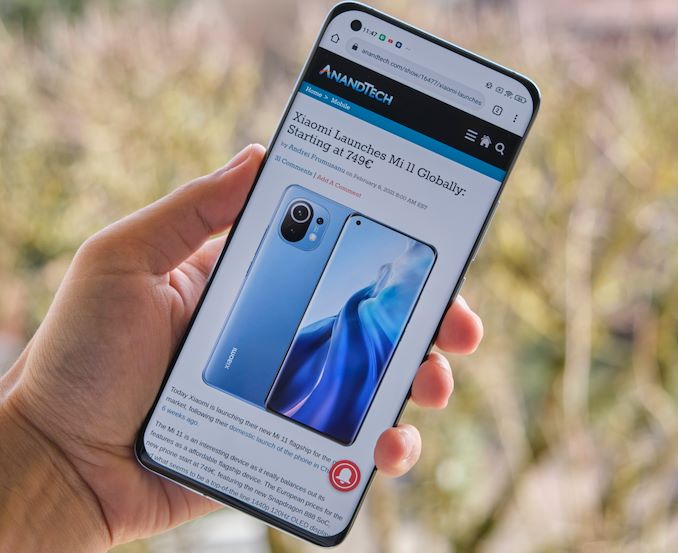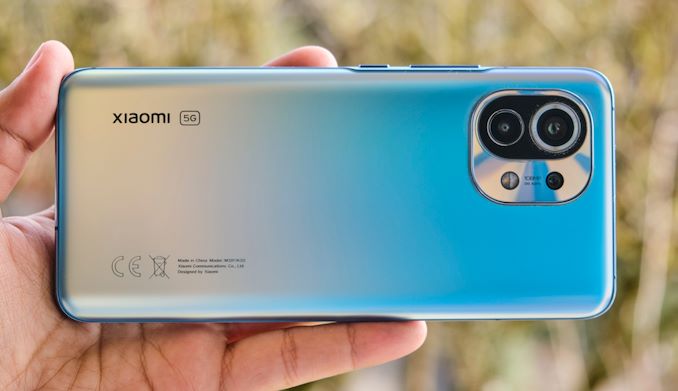The Xiaomi Mi 11 Review: A Gorgeous Screen and Design
by Andrei Frumusanu on March 10, 2021 8:00 AM EST- Posted in
- Mobile
- Smartphones
- Xiaomi
- Snapdragon 888
- Mi 11
Conclusion & End Remarks
Xiaomi’s flagship devices have always been quite interesting as alongside Samsung they’re always the first amongst a new generation of phones each release cycle. This means that at least from a technical standpoint, they have far fewer competition at this point in time before other vendors catch up with their release in the coming months. The Mi 11 is a real step-up for Xiaomi as it combines a few key changes that do differentiate it quite a lot to last year’s Mi 10 series.
The design of the Mi 11 – at least from the front of the phone, is rather iterative over the Mi 10, however with a few changes such as the now flowing frame edges and the front glass panel that is now also slightly curved at the top and bottom of the phone. Xiaomi has been able to reduce the weight and thickness of the phone which in my view is a general positive to the ergonomics of the phone.
The big new upgrade of this generation has been the display. A new 1440p 120Hz panel really augments the device from previous generation iterations and in terms of picture quality it’s absolutely a phone that competes with the best of that’s currently available in the market.
The one aspect where the display doesn’t keep up is in terms of its under-the-hood technology. It doesn’t feature any VRR – either software or hardware, and this means that the power consumption at 120Hz is quite bad.
Edit March 12th: The Mi 11 does have a coarse software-based refresh rate switching mechanism, however it does not function below 110 nits screen brightness (around 70% on the brightness slider).
On top of that, the phone seems to suffer from quite high base power consumption even at 60Hz, well beyond that of other phones, and this results in less than expected battery life for the device. It’s not unusable, but it’s definitely not competitive with other same-class devices in the market.
Performance of the Mi 11 is fantastic thanks to the Snapdragon 888. As of right now, it very much could be said that it’s the fastest Android device in the market, due to how Xiaomi is being more aggressive with the thermal envelope of the phone, compared to Samsung. There’s still doubts about the generational gaming performance improvements here, as it still cannot fully harness the new Snapdragon’s full performance for prolonged periods, but it’s likely the best we’re going to see for 2021 Android phones.
The camera performance of the Mi 11 is quite strong. In daylight, the camera’s ability to capture in 27MP mode means that it results in pictures that are of higher detail than anything the competition is able to offer, although dynamic range doesn’t quite go as far. Xiaomi has also a much more natural look to its details, and aren’t as over-sharpened or processed as other competitors’ results. Generationally, Xiaomi has also improved its colour temperature processing which in my view is one of the biggest changes over the Mi 10 series, and that’s a bigger positive.
In terms of telephoto – because the device doesn’t have a dedicated module, you’d think that it doesn’t do as well in this aspect of photography. That’s actually not quite correct, as Xiaomi is able to take advantage of the 108MP main sensor’s sheer resolution at higher magnifications. Even at a 2x magnification, the Mi 11 tends to do better than other devices in the market. Of course, it can’t compete against periscope implementations at far longer focal lengths.
In low-light, the Mi 11 is an adequate performer and above-average, though there are competitors which do better. Particularly the ultra-wide angle is lagging behind the superior hardware of some of the competition.
A winner at 749€, though availability is scarce
The most attractive aspect of the Mi 11 is its price. Starting at 749€ MSRP, the phone offers a very compelling package that I think rationalises itself against the nearest competition. The nearest competition of course is the Galaxy S21+ which lands in at 849€ at the time of writing. The Xiaomi has a higher quality screen, generally better main camera module (though worse ultra-wide), a more premium design and build, a faster SoC (In Exynos markets), however it’s likely to have notable worse battery life.
For our readers in the US of course, the phone won’t be officially available at all unless you somehow get an imported unit, so it’s not really a viable option for consideration.
What’s actually more of an issue is the availability of the phone in other western markets. At the time of writing the Mi 11 isn’t readily available yet in Europe, so while we’ve reviewed the phone and deemed it good, it’s still very hard to get one. If that situation changes in the coming weeks, then the Mi 11 should be a strong contender.












85 Comments
View All Comments
ZoZo - Wednesday, March 10, 2021 - link
Curved edge screen? Next.yankeeDDL - Wednesday, March 10, 2021 - link
Really? Why? I have an S8 (yes, Samsung S8, 4 years old and counting) with edge screen. It still works perfectly, it is a pleasure to hold and it has some decent edge effects that are actually useful.I'd definitely consider another phone with curved edges.
I look forward to something a tad smaller than this though: 6" for example.
I hate the fact that on Android if you want the top of the line HW you get it only on huge phones.
Wereweeb - Wednesday, March 10, 2021 - link
Because it's terrible to use and distorts images. It's stupid and should stop existing. I say this as a former S6 Edge user (I didn't buy it, it was handed down to me)theblitz707 - Friday, March 26, 2021 - link
thats your opinion. i never had a problem with my curves s10+ and quite like it, it makes the screen look more premium and i never felt a distortion problem when watching videos. in fact compared to 11 pro max, that looks like a phone from years ago.inighthawki - Wednesday, March 10, 2021 - link
Am I the only one who prefers a phone with a flat rectangle for a screen with no curves, notches, or rounded corners cutting off or warping various parts of the display?Wereweeb - Wednesday, March 10, 2021 - link
Eh, rounded corners makes it easier to hold, and doesn't really compromise images that much. I'll take notches over hidden cameras, but otherwise I also dislike them, and prefer pop-up cameras or a camera between the housing and the display.inighthawki - Thursday, March 11, 2021 - link
I guess I mean that I'm fine with having a bezel on the top/bottom for that kind of thing. The phone itself can still have some roundedness on the corners. For example right now I use a pixel 2 and love it. I think they could shrink the bezels without sacrificing the screen being a rectangle.And while the corners dont really compromise much, it's something that forces software developers to work around. For example, if you're right a game, you now have to query APIs to know how rounded the corners are to ensure you aren't putting text or status icons somewhere the user can't see. Like imagine if your desktop's monitor had rounded corners and it forced Microsoft to update the taskbar so that the start button wasn't flush against the edge. It serves no purpose. You're quite literally just losing functionality. And on a phone it's done for no other reason than the bragging rights of claiming the display is 0.2" larger than the previous generation with zero bezels.
inighthawki - Thursday, March 11, 2021 - link
If you're writing a game*Stupid no edit button :(
hanselltc - Thursday, March 11, 2021 - link
minor curved corners are acceptable if it truly helps the phone keep a more handleable shape. if it has a chin and/or a forehead, then it is stupid. other cutouts are all absolutely asinine.MetaCube - Thursday, March 18, 2021 - link
Rounded corners are great, stop smoking glue